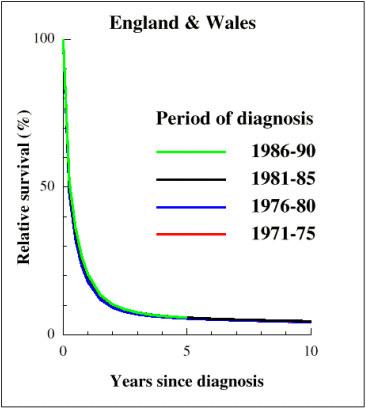In England and Wales lung cancer is the biggest cancer killer in men and third biggest in women.1 In England and Wales the incidence of lung cancer per year is 25,000 new cases in men and 12,000 new cases in women. lung cancer alone accounts for 6% of death from all causes.1,34
The incidence rates in the UK are comparable to those in other developed countries, approximately 100 per 100,000per year. Less developed regions currently have significantly lower incidences 35 and mortality rates36 for lung cancer.
 The UK incidence rates in men is currently decreasing, having reached a peak in the 1970s when it was the highest in
the world, falling by approximately 7-10% every five years. This contrasts with the incidence in women, which was
rising at 10% every five years until the 1980s, since which the increase has slowed. It is interesting to note that
these trends mirror earlier trends in smoking.1
The UK incidence rates in men is currently decreasing, having reached a peak in the 1970s when it was the highest in
the world, falling by approximately 7-10% every five years. This contrasts with the incidence in women, which was
rising at 10% every five years until the 1980s, since which the increase has slowed. It is interesting to note that
these trends mirror earlier trends in smoking.1
Due to the poor survival rates with lung cancer, mortality rates closely follow those of incidence.1 As is shown in this graph, the survival rates in lung cancer have shown little improvement over the last twenty years, with England lagging behind Europe and the USA.1 The increase in five-year survival rates has been less than 1% every five years compared with a 20% increase in survival for melanoma, and a 10-15% increase for all cancers.1
The Trent cancer registry records cases of lung cancer in the Trent region i.e. South Yorkshire, Lincolnshire, Derbyshire, Nottinghamshire and Leicestershire. The incidence of lung cancer in Trent was 2114 for males and 1063 for females in 1997, this corresponds to an age standardised rate of 88.7 per hundred thousand per year in males and 43.7 per hundred thousand per year in females.37 The most recent published figures for England and Wales are for 1992, these put the age standardised rate at 89.7 per 100,000 per year (males) and 33.9 per 100,000 per year (females).37 Given the five year difference between these two sets of figures it is difficult to compare them, however we can see that they are of a similar order.
|
Leicestershire |
Trent |
|||
|
Year |
Male |
Female |
Male |
Female |
|
1984 |
93.5 |
24.9 |
108.0 |
30.1 |
|
1985 |
80.3 |
24.4 |
105.8 |
30.0 |
|
1986 |
98.8 |
25.4 |
101.9 |
30.0 |
|
1987 |
81.8 |
21.7 |
99.2 |
29.3 |
|
1988 |
82.8 |
21.8 |
96.5 |
30.2 |
|
1989 |
80.0 |
23.8 |
92.5 |
28.1 |
|
1990 |
78.5 |
23.9 |
89.4 |
30.1 |
|
1991 |
68.3 |
21.6 |
90.0 |
30.1 |
|
1992 |
65.7 |
23.0 |
88.4 |
31.2 |
|
1993 |
70.5 |
26.4 |
93.2 |
31.9 |
|
1994 |
65.7 |
24.4 |
80.9 |
29.9 |
|
1995 |
61.7 |
24.2 |
72.5 |
30.0 |
|
1996 |
65.0 |
25.9 |
75.3 |
32.6 |
|
1997 |
61.6 |
27.1 |
77.5 |
31.3 |
|
Figures given are incidence per 100,000 per year |
||||
In this table data from the Trent Cancer registry shows the age standardised rates in Leicestershire of lung cancer between 1984 and 1997.38 This data shows us that the lung cancer incidence rates in Leicestershire follow the same general trends as England and Wales, though the rates are significantly lower than the Trent figures. Leicester is also found to have a lower incidence of all malignant neoplasms.37 Leicester is quite an affluent part of Trent and it is possible that there is a link between these differences in cancer incidence and the relative wealth of the area. Data from the Office of National Statistics1 links the incidence of lung cancer to deprivation indicators, higher deprivation being related to higher lung cancer incidence.
The high incidence of lung cancer and the poor prognosis are cause for concern. The government have recognised this39 and in the 1998 white paper �Smoking kills�40> they outline a strategy to combat the deaths from lung cancer and other diseases related to smoking by reducing cigarette consumption. They aim to do this through a network of smoking cessation clinics, support for people trying to quit including nicotine replacement therapy and the banning of tobacco advertising. Previous targets to reduce teenage smoking set in the �Health of the nation� (1992)41 were not achieved, in fact the trend was for an increase rather than a decrease. The 1999 government white paper �Saving lives: our healthier nation� sets the target of reducing the death rate from cancer by 2010 in the under 75s by a fifth.
